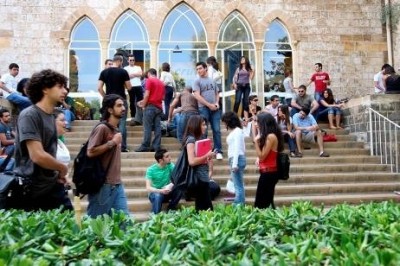
With women now making up more than half the student body across the Arab region – and close to two-thirds in the United Arab Emirates and Qatar – universities are rushing to open new campuses to better meet their needs. The trend is particularly evident in the Gulf countries, which are experimenting with innovative ways to teach young women the critical thinking skills they need to thrive in the modern economy without upsetting traditional mores that strictly curtail mingling between the sexes.
Until recently, Gulf women were often taking the same classes from the same teachers as the men, but at different times. Some classes – notably in engineering – were off-limits entirely.
Now a surge in women’s colleges has made women’s education a priority instead of treating them as an afterthought. They’ve done so by creating male-free safe zones where women are encouraged to speak their minds.
Bahrain’s Royal University for Women, for example, provides “a comfortable environment in which to create leaders,” the school boasts on its website. “Our main focus is on academic excellence and personal development.”
The new schools are proving attractive to female students from conservative families for a whole host of reasons.
For many young Arab women – in the Gulf as well as in more liberal countries – time at university is a longed-for period of freedom before they start a family. But conservative Gulf culture forbids them from traveling without authorization from a male relative, effectively ruling out studying abroad for many of them.
Local public institutions that serve both men and women are one option, but the strict separation between the sexes applies on campus, as it does everywhere else in countries such as Saudi Arabia and the UAE. That can prove stifling for young women, who are expected to remain self-effacing in the presence of male students or teachers.
When the UAE’s Zayed University saw a drop in female enrollment after it began serving male students a few years ago, for example, Vice-Provost Bryan Gilroy was quick to reassure parents and students that a Western-style coed campus wasn’t in the making.
“Male and female students do share the same facilities: the library in Dubai for example, but at completely different times,” Gilroy told The National at the time. “Male and female students do not come into contact with each other at any time of the day.”
The UAE’s largest public university, the Higher Colleges of Technology, in contrast, offers separate campuses for men and women at six of its colleges across the country.
Saudi Arabia has also increasingly followed that model in recent years.
In 1999, the kingdom launched Effat and Dar Al-Hekma universities specifically for women. A decade later, King Adbullah inaugurated the $2 billion Princess Nora Bint Abdulrahman University in Riyadh, the world’s largest university for women, with more than 42,000 students enrolled in some 32 campuses across the capital region.
Other Gulf countries have followed suit.
Bahrain opened the doors of its Royal University for Women in Riffa in 2006. Box Hill College in Kuwait, an extended campus of Australia’s Box Hill Institute offering two-year degrees, began operations in 2007.
Outside of the Gulf region, Egypt’s Ain Shams University, the country’s third-oldest nonsectarian public university, offers coed classes at most of its colleges but also runs a Women’s College for Arts, Science and Education.
Educators say they’re empowering women and giving them role models to emulate, as well as lifelong access to networks of like-minded alumnae, within strict boundaries.
“I am in a position where I have to draw balance between cultural norms and demands for reform and change,” Effat’s president, Haifa Jamal al-Lail, told her alma mater, the University of Southern California’s Price School of Public Policy, in a 2012 interview for the school’s newsletter. “I am leading an ambitious academic institution that is missioned to qualify tomorrow’s competitive leaders with a world-class education by providing an interdisciplinary environment in a conservative society.”
Jamal al-Lail said the private school has grown, despite its relatively high price tag in a country that offers free schooling at its public universities.
“We succeeded in overcoming this challenge by offering new programs that have not been offered to girls before, like Architecture and Electrical and Computer Engineering,” Jamal al-Lail told the USC newsletter.
In addition, she said, graduates can get help from the university’s Effat Alumnae Association, whether they’re pursuing further education or job opportunities.
“EAA provides valuable benefits and programs that allow around 400 alumni to tap into a vast network of national and international relationships,” she said.
Employment remains a real challenge for educated Arab women, however.
A landmark World Bank report in 2013 found that only 25 percent of women in the Middle East and North Africa had jobs – half the global rate. Meanwhile, in Egypt, unemployment rates for young female university graduates are up to three times higher than those for men, according to Al-Fanar Media.
While many factors help explain those disparities, including societal pressure to start a family, they’re compounded by policies in more conservative countries that prohibit mingling of the sexes in the workplace and that discourage women’s participation in certain activities, including in the energy sector.
“Labor laws can limit opportunities for women by not allowing their entry into industries that are deemed dangerous, hazardous, or morally harmful to their reputations. Restrictions on night work also bar women from making their own decisions as to where and when they work,” the World Bank report states.
The report goes on to state that “Egypt, Kuwait, Morocco, Saudi Arabia, Syria, the United Arab Emirates, and the Republic of Yemen all have labor restrictions on work that may be ‘morally harmful’ or could affect women’s social standing. The ultimate effect of all these types of restrictions can be to prevent women from participating in substantial sectors of the economy.”
Al-Monitor

Leave a Reply
You must be logged in to post a comment.